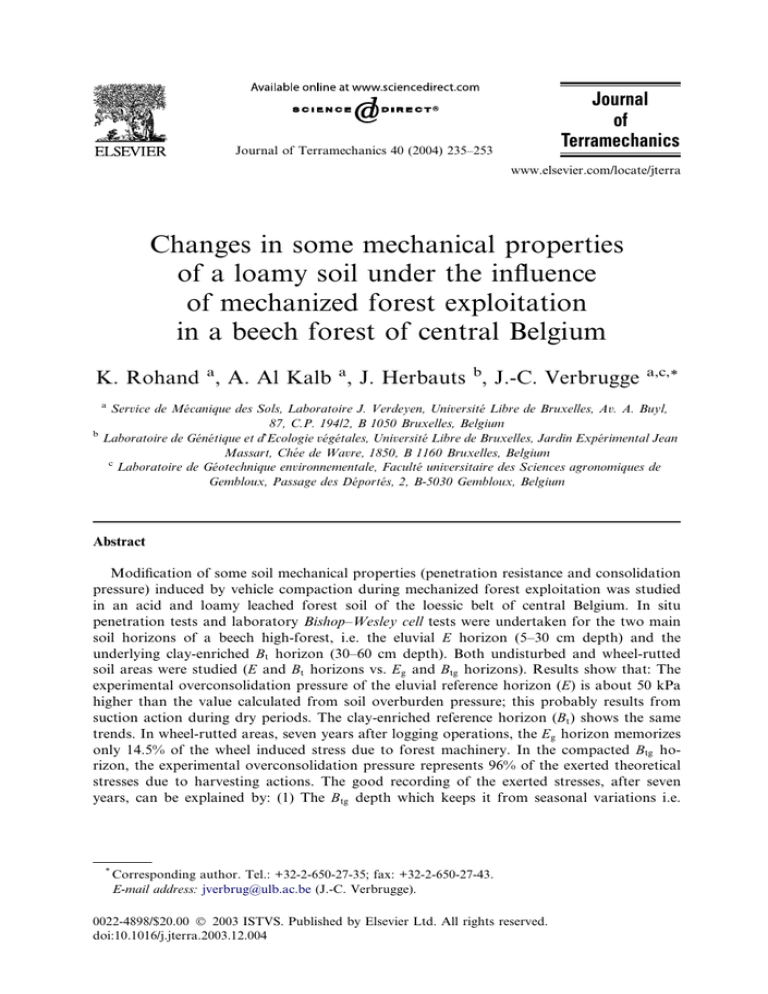
Journal
of
Terramechanics
Journal of Terramechanics 40 (2004) 235–253
www.elsevier.com/locate/jterra
Changes in some mechanical properties
of a loamy soil under the influence
of mechanized forest exploitation
in a beech forest of central Belgium
K. Rohand a, A. Al Kalb a, J. Herbauts b, J.-C. Verbrugge
a,c,*
a
b
Service de Mecanique des Sols, Laboratoire J. Verdeyen, Universite Libre de Bruxelles, Av. A. Buyl,
87, C.P. 194/2, B 1050 Bruxelles, Belgium
Laboratoire de Genetique et dÕEcologie vegetales, Universite Libre de Bruxelles, Jardin Experimental Jean
Massart, Chee de Wavre, 1850, B 1160 Bruxelles, Belgium
c
Laboratoire de Geotechnique environnementale, Faculte universitaire des Sciences agronomiques de
Gembloux, Passage des Deportes, 2, B-5030 Gembloux, Belgium
Abstract
Modification of some soil mechanical properties (penetration resistance and consolidation
pressure) induced by vehicle compaction during mechanized forest exploitation was studied
in an acid and loamy leached forest soil of the loessic belt of central Belgium. In situ
penetration tests and laboratory Bishop–Wesley cell tests were undertaken for the two main
soil horizons of a beech high-forest, i.e. the eluvial E horizon (5–30 cm depth) and the
underlying clay-enriched Bt horizon (30–60 cm depth). Both undisturbed and wheel-rutted
soil areas were studied (E and Bt horizons vs. Eg and Btg horizons). Results show that: The
experimental overconsolidation pressure of the eluvial reference horizon (E) is about 50 kPa
higher than the value calculated from soil overburden pressure; this probably results from
suction action during dry periods. The clay-enriched reference horizon (Bt ) shows the same
trends. In wheel-rutted areas, seven years after logging operations, the Eg horizon memorizes
only 14.5% of the wheel induced stress due to forest machinery. In the compacted Btg horizon, the experimental overconsolidation pressure represents 96% of the exerted theoretical
stresses due to harvesting actions. The good recording of the exerted stresses, after seven
years, can be explained by: (1) The Btg depth which keeps it from seasonal variations i.e.
*
Corresponding author. Tel.: +32-2-650-27-35; fax: +32-2-650-27-43.
E-mail address: jverbrug@ulb.ac.be (J.-C. Verbrugge).
0022-4898/$20.00 Ó 2003 ISTVS. Published by Elsevier Ltd. All rights reserved.
doi:10.1016/j.jterra.2003.12.004
236
K. Rohand et al. / Journal of Terramechanics 40 (2004) 235–253
from desiccation–moistening or freeze–thaw cycling; (2) amorphous and free iron accumulation inducing a ‘‘glue’’ effect of the Btg soil matrix, which could stabilize the soil structure
and prevent recovery to initial conditions. These results provide clear evidence that on
loessic materials, soil compaction due to logging operations leads to modifications in both
physical (bulk density, total porosity) and mechanical (penetration resistance and consolidation pressure) soil properties.
Ó 2003 ISTVS. Published by Elsevier Ltd. All rights reserved.
Keywords: Soil compaction; Soil degradation; Rutted forest soils; Overconsolidation pressure
1. Introduction
In forest ecosystems, the increase in size, power and weight of forest machinery is
one of the main causes of soil degradation (soil compaction and related effects) [1,2],
the soil being subjected to severe stresses due to mechanical forces exerted by tractor
tyres and skidding. Results of soil compaction include the increase in bulk density,
the reduction in macroporosity, and, consequently, reduced soil aeration and water
holding capacity [3–6]. This results in a poor rooting, inducing lower uptake of
nutrients and water, and possibly a decrease in tree growth [2,7,8] or an increase in
sensitivity of radial growth [9]. Moreover, soil compaction and root damage increase
the risks for windthrow and infection by root pathogens [10,11].
Soil susceptibility to compaction is mainly determined by particle-size composition, organic matter content and biological activity level. Biological activity is particularly important for soil structural regeneration. Therefore, more attention should
be given to degradation in fine-textured and acid forest soils, with low levels of biological activity [12]. These soils are known to be very sensitive to compaction especially where natural soil remediation is very low or even non-existent [3,13,14].
In the loessic belt of central Belgium, the silvicultural management of loamy soils
developed under beech stands frequently results in severe soil physical degradation,
which causes surface waterlogging (gleization) in the areas compacted by wheel-ruts
[5,15]. In such conditions, natural forest regeneration is impeded and costly soil
improvements may be necessary before planting trees. Moreover, soil compaction
due to machine traffic is often referred to as an important aggravating factor in beech
decline [16].
In spite of their importance for a sustainable forest management, few analytical
data have been published in regard to the degradation of soil physical properties
under the influence of repeated wheeled traffic during logging operations and, to our
knowledge, changes in soil mechanical properties have been appraised in a forest
environment only recently [37,38]. The aim of this study is therefore to use mechanical laboratory tests (Bishop–Wesley cell tests) to determine to what extent the
mechanical properties and mainly compressibility of a loamy soil developed under a
beech forest are affected by logging operations. Previous results had shown that a
‘‘cementation’’ effect as defined by Biarez et al. [17] was detectable in the mid-depth
horizon of the wheel-rutted areas [6].

